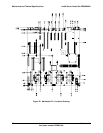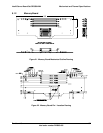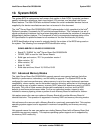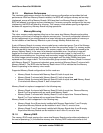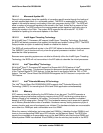
Intel® Server Board Set SE8500HW4 System BIOS
Revision 1.0
Intel order number D22893-001
73
10.2 Rolling BIOS
The Intel
®
Server Board Set SE8500HW4 BIOS can be updated while the server is online, as
opposed to immediately turning off the server after a BIOS update. This rolling BIOS features is
supported by having two copies of the BIOS, the one in use, and a secondary copy, to which an
updated BIOS version can be written. When ready, the system can roll forward to the new
BIOS. In case of a failure with the new version, the system can roll back to the previous version.
The Intel
®
Server Board Set SE8500HW4 does not automatically use the new BIOS, a reboot
must happen to move to the new BIOS.
The Firmware Hub (BIOS flash) is divided into two partitions: primary and secondary. The active
partition from which the system boots shall be referred to as the primary partition. The BIOS
updates are written to the secondary partition. After the update, a notification flag will is set, and
after subsequent boot following the BIOS update, the system will boot from the new primary
BIOS partition. If the new BIOS fails to boot, specialized hardware will switch back to the BIOS
on the other partition, thus affecting a “Roll Back”. BMC logs events associated with the BIOS
updates to the SEL.
10.3 Initialization
10.3.1 Processors
The Intel
®
Server Board Set SE8500HW4 has two processor front-side buses, each
accommodating two processors. At reset, hardware arbitration will choose one BSP per FSB.
However, the BIOS POST code requires only one processor for execution. This requires the
BIOS to elect a “system BSP” using registers in the NB. The BIOS cannot guarantee which
processor will be the system BSP, only that a system BSP will be selected. From this point
forward, the system BSP will be referred to as just the BSP.
The BSP is responsible for executing the BIOS power-on self-test (POST) and preparing the
machine to boot the operating system. At boot time, the system is in virtual wire mode and the
BSP alone is programmed to accept local interrupts (INTR driven by programmable interrupt
controller) and non-maskable interrupt (NMI)).
As a part of the boot process, the BSP wakes each AP. When awakened, an AP programs its
Memory Type Range Registers (MTRRs) to be identical to those of the BSP. All APs execute a
halt instruction with their local interrupts disabled. If the BSP determines that an AP exists that
is a lower-featured processor or that has a lower value returned by the CPUID function, the BSP
will switch to the lowest-featured processor in the system. This algorithm is described in
[IA32_BWG]. The System Management Mode (SMM) handler expects all processors to respond
to a Server Management Interrupt (SMI).
See Section 5.4 for more information on the BIOS and BMC interaction during the initial fault
resilient booting process.
An FRB3 failure is recorded automatically by the BMC while AP failures are logged to the SEL
by the BIOS.
The BMC maintains failure history for each processor in nonvolatile storage. There are three
possible states for each processor slot:




